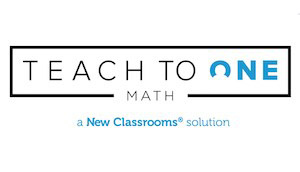Children throughout the state will benefit from Teach to One’s math learning solutions.
 Educational organizations are taking pivotal steps to meet all student needs and replace the outmoded teaching methods that leave struggling students behind. Amid these efforts, The Texas Education Agency (TEA) has selected New Classrooms’ Teach to One solutions to support the state’s Math Innovation Zone (MIZ) initiative. As a MIZ partner, Teach to One will redefine instructional practices and support MIZ’s mission to integrate math blended learning practices throughout the state. Teach to One will design, launch, and scale blended learning solutions to help Texas’ 5.4 million children meet their individual learning goals.
Educational organizations are taking pivotal steps to meet all student needs and replace the outmoded teaching methods that leave struggling students behind. Amid these efforts, The Texas Education Agency (TEA) has selected New Classrooms’ Teach to One solutions to support the state’s Math Innovation Zone (MIZ) initiative. As a MIZ partner, Teach to One will redefine instructional practices and support MIZ’s mission to integrate math blended learning practices throughout the state. Teach to One will design, launch, and scale blended learning solutions to help Texas’ 5.4 million children meet their individual learning goals.
Now a TEA-approved curriculum provider, Teach to One is set to strengthen its school partnerships with Texas-based educational institutions that are participating in the MIZ initiative. Over the last year, Ector County Independent School District has launched Teach to One in three middle schools, which has been hugely beneficial, especially in transitioning math classes online for lockdown. Teach to One is set to reach even more students in Texas over the upcoming months.
“We are excited to bring tailored acceleration to schools and districts that share our belief about how students can learn best,” says Chris Rush, co-founder and chief program officer of New Classrooms. “We are thrilled to be partnering with the state of Texas in this important endeavor.”
The Math Innovation Zone Initiative
The Math Innovation Zone initiative – the United States’ first enterprise that prioritizes personalized student learning – sets a national policy model for states to remove barriers to innovative education. Reports from the iceberg problem recommend the initiative as a solution to addresses educational challenges arising from incomplete learning that other states should adopt.
The Iceberg Problem
The Iceberg Problem refers to the fact that when a child is struggling to grasp a concept, their challenge is usually rooted in a bigger problem. This is especially true in math, as students often need a grounded understanding of one concept, such as decimals, before they can progress to another, such as percentages. When a student hasn’t grasped one mathematical concept, they struggle to grasp related concepts. The more these concepts mount up, the bigger the collection of unfinished learning. Like an iceberg, much of that unfinished learning remains hidden from view.
New Classrooms has produced a report to address how teachers can overcome the iceberg problem in middle school math classes by embracing blended learning principles and using Teach to One’s dynamic modalities.
Blended Learning
As part of the Blended Learning Grant Program (BLGP), the MIZ initiative is founded on the understanding that every child has a different level of comprehension. Currently, many teachers are directing lessons at students who have an average understanding of the curriculum topic, meaning that advanced students are gaining little benefit and students who are struggling are left behind. These lessons are only effective for mid-ability children.
Teachers need more support if they are to help all students. With a blended learning plan in place, teachers can focus on small groups who need face-to-face instruction, while more advanced students can focus on personalized online activities. Not only does blended learning encourage students to take control of their time management and learning paths through personalized online activities, but the approach also allows schools to adopt hybrid blends of four modalities – rotational, flex, a la carte, and enriched virtual – to meet individual student needs. With Teach to One, schools can leverage technology to assist teachers in their efforts to pinpoint the best academic path for each student.
Multiple third-party studies have confirmed the academic benefits that children can reap from blended learning. In particular, the RAND Corporation ran a nationwide study in 2015, which concluded that children following blended learning systems achieve significant academic gains in math classes.
About Teach to One
Founded on the idea that connecting modalities in math studies helps create integrated learning experiences, Teach to One combines many teaching approaches so that students can follow personalized learning plans. Every student follows a different blend of Teach to One activities to meet customized goals based on individual success criteria. The adaptive personalized curriculum uses analytics from historical learner patterns, learner attributes, and lesson characteristics to map a personalized educational route for each student. With quality at the heart of Teach to One’s solutions, New Classrooms’ team of academic and curriculum specialists rigorously reviews the modalities to continuously raise standards.
Teach to One students engage in 35-minute sessions that are tailored to their exact needs. Each session is different to keep students engaged and motivated, with activities spanning from virtual instructions, tutoring, and independent practices to small-group collaborations, live investigations, peer-to-peer tasks, and teacher-led sessions. At the end of each math lesson, students take a quiz that determines the activities for their next personalized lesson. This approach allows students to develop the math concepts that they need to work on, instead of the concepts that outdated educational policies dictate. Students following the Teach to One approach don’t compete with their peers; the only person they’re trying to better is themselves.
Learn more about Teach to One at https://newclassrooms.org.



